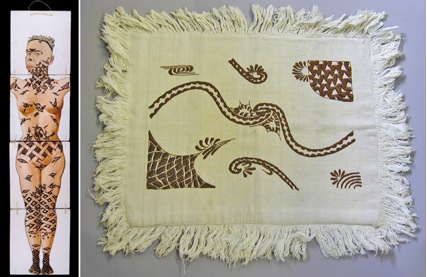Uli designs
 Bequeathed by Edward Harland Duckworth in 1972; 1972.24.16 and .172Ìgbò people, Nigeria, 1930s–1940s
Bequeathed by Edward Harland Duckworth in 1972; 1972.24.16 and .172Ìgbò people, Nigeria, 1930s–1940s
The drawing on paper was made in Arochukwu, south-eastern Nigeria in the 1930s or 1940s. It may have been one of a series of drawings commissioned specifically for a British collection via the Scottish missionary Agnes Siddons Arnot, before entering into the possession of Edward Harland Duckworth who was a colonial official in Nigeria until 1953.
The drawing is comprised of four separate sheets of paper stitched end-to-end to form an artwork more than one metre in length. A Western-trained artist – possibly Mrs Arnot herself – probably drew the outline of the body and several local Ìgbò women may have filled in the patterns. The style of patterning is called ùrì or ùlì, after the dye of the ùlì plant that was often used as a medium. Here, the model's pale skin may have been a device to clearly illustrate the patterns, or it may represent the camwood 'wash' that was occasionally applied to the body prior to the ùlì.
Ùlì designs were painted by Igbo women on their bodies and as murals on clay walls. They were worn not only to make a vivid artistic statement but also to communicate socio-cultural values and meanings. Everyday wear called for simpler designs whilst more complex versions were applied for special events such as weddings, title ceremonies, and funerals.
Despite taking a long time to apply, ùlì body designs would fade after a week and those painted onto house walls would wash off in the rainy season. Far from being problematic, this ephemeral nature of ùlì is one of its defining characteristics. Whilst missionaries, colonial civil servants, traders and naval officers stove to collect permanent archives of ùlì in the forms of photographs, descriptions and drawings like the one here (indeed, the Pitt Rivers Museum houses more than 100 drawings of ùlì on paper), such things did not – and do not – particularly concern the Ìgbò. Not only do they accept this art form as temporary, they believe everyone has a "third eye" in order to see the spirit world. Through this eye it is possible to recall and reconstruct the memory and meaning of the art.
Both female body and mural ùlì painting are closely associated with Ìgbò religion and they began to decline as Christian missionaries arrived in Nigeria from the 19th century onwards. Local women were discouraged from decorating their bodies and their artistic capacities was directed towards other activities such as needlework, in which designs were adapted for embroidery patterns. Beautifully decorated cushion covers (such as this), tablecloths and other textiles were often made for sale with the profits going to the mission. Indeed, in an interview with a Nigerian magazine some years later, Arnot said that she founded her embroidery cooperative using ùlì body painting designs "with the intention of preventing this art being lost."
Today, only the older members of the Ìgbò community generally practise traditional ùlì body art. The transition of many people from clay to cement homes has led to a decline in mural painting too. However, since the 1970s, both female and male contemporary Nigerian artists have striven to keep ùlì alive by incorporating designs into other media such as watercolour, printmaking, mosaic and sculpture.
